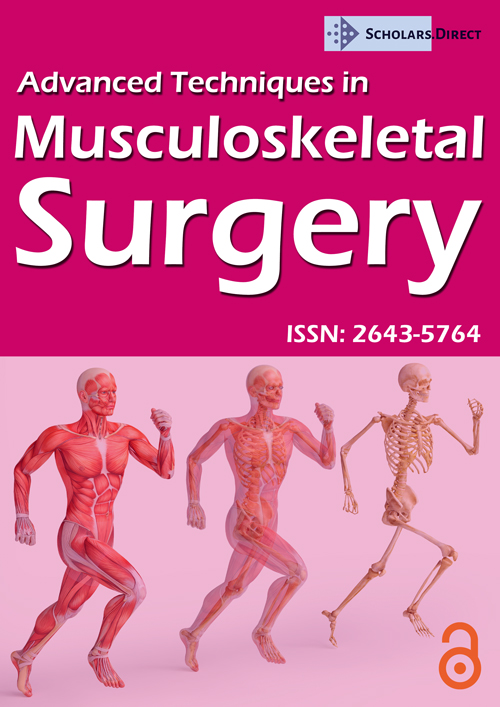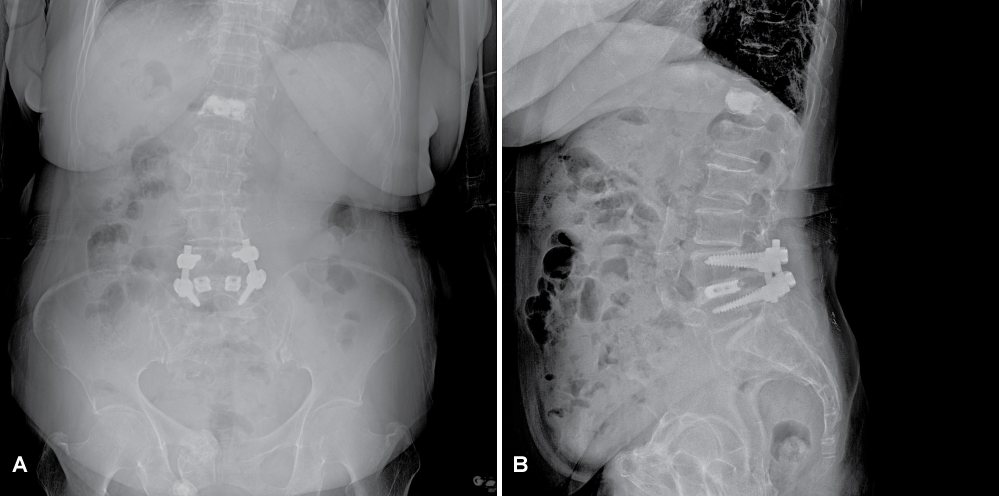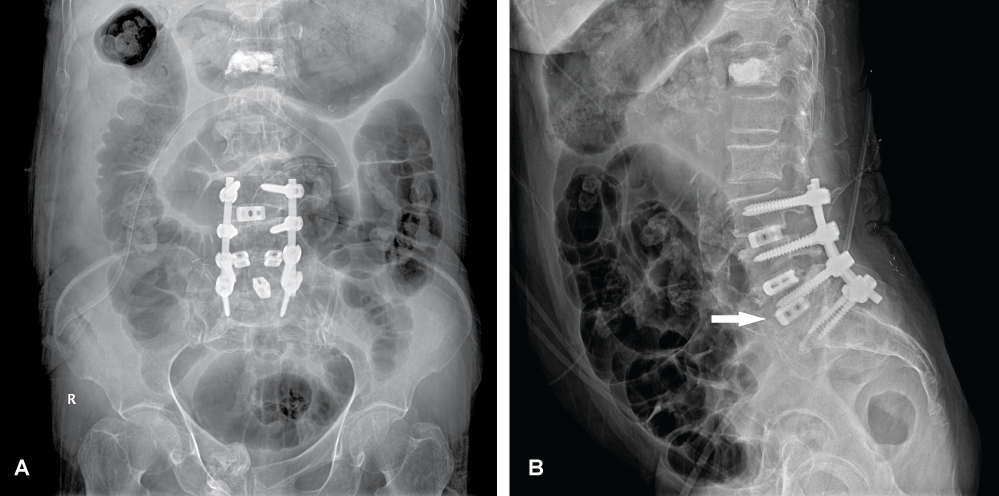Perforation of the Adjacent Vertebral Body by Interbody Cage during Posterior Lumbar Interbody Fusion: A Case Report
Abstract
While Posterior Lumbar Interbody Fusion (PLIF) is routine within the spinal surgeon's repertoire, it is surgery with the potential to cause significant associated complications. In particular, cage migration and cage subsidence are often reported. The purpose of the study was to report a case of intraoperative penetration of a fusion cage into the adjacent vertebral body after PLIF. A 79-year female underwent revision PLIF surgery from L3 to S1 was performed using titanium threaded cages (length 25 mm, height 9 mm) with autogenous bone graft following posterior instrumentation. After PLIF, postoperative radiograph revealed that one cage perforated the superiorly adjacent endplate and lay completely within the vertebral body of L5. Emergency revision surgery was performed and another cage was inserted after decompression and evacuation of subdural hematoma. To the best of our knowledge, few reports have been previously issued on immediate perforation of the superiorly adjacent endplate by interbody cage during PLIF and following revision surgery. The known risk factors for cage penetration/subsidence should be considered before or during lumbar interbody fusion surgery.
Keywords
Cage, Complication, Penetration, Posterior lumbar interbody fusion
Introduction
The procedure of Posterior Lumbar Interbody Fusion (PLIF) is a reliable treatment option and has become increasingly popular for treatment of spinal stenosis, degenerative disc disease, and spondylolisthesis. Nowadays, it is well established procedure with good to excellent results and fusion rates from 90% to 100% with few severe complications [1,2]. Along with the increasing size of the elderly population, interbody fusion will continue to be a mainstay surgical intervention for alleviation of neurologic symptoms secondary to degenerative spine conditions [3].
Although current PLIF procedures are the result of considerable development, various implant-related complications can occur, including pedicle screw misplacement, nerve root injury, thromboembolic events, vascular or visceral injury, and late spinal instability [4]. Implantation of a single cage from one side can result in certain side effects months to years after PLIF such as cage migration and subsidence [5]. However, few reports [4] have been previously issued on immediate perforation of the adjacent vertebral body by interbody cage.
Here, we report a patient with intraoperative penetration of a cage into the adjacent vertebral body after the revision PLIF procedure and following re-revision surgery due to compression of nerve roots and intensified neurological symptoms.
Case Report
A 79-year female presented with a 3 month history of severe claudication and lumbar cruralgia in the right L5 dermatome. The patient's previous history revealed a PLIF procedure at L4 to L5 in 10 years ago (Figure 1). Comprehensive conservative treatment failed to improve her symptoms. Lumbar MRI showed adjacent segment disease in L3/4 and L5/S1 with compression of the right L3 and L5 nerve root. She had severe osteoporosis (T-score, -3.5). Revision PLIF surgery from L3 to S1 was performed using titanium threaded cages (length 25 mm, height 9 mm, Lospa® IS™, Corentec) with autogenous bone graft following posterior instrumentation. Postoperative radiograph revealed that one cage perforated the inferior endplate of the adjacent vertebral body (L5/S1) and lay completely within the vertebral body of L5 (Figure 2). Due to compression of nerve roots by hematoma and intensified neurological symptoms, we performed emergency a right-sided selective decompression at L5/S1. During re-revision surgery, the cage was not visible and could not be removed or repositioned. Instead, the allograft bone chips were packed into the disc space and another cage was inserted after decompression and evacuation of epidural hematoma (Figure 3). A dramatic improvement in the right leg pain was achieved immediately after the secondary revision surgery. At 1 year follow-up, she was symptom free and plain radiographs showed inevitable positioning of the cage.
Discussion
Segmental stabilization and spine fusion may be a necessary adjunct to neurologic decompression in the degenerated spine. The adoption of titanium interbody cages resolved the problems arising from autograft harvesting and has provided immediate stability to spinal levels, restoration of the disc space and neuroforaminal height, and a larger surface area, and thus, better fusion rate [6]. However, some cage-related complications, such as, cage migration or subsidence, may occur.
A cage subsidence is usually defined as a gradual migration of > 2 mm into the adjacent vertebral body and the incidence of cage subsidence after lumbar interbody fusion surgery varies greatly [7], depending on the exact surgical technique, the extent of endplate preparation, the cage type and size, and the degree of osteoporosis, reaching a rate of up to 76.7% [1,8]. However, few reports have been previously issued on immediate perforation of the adjacent vertebral body by interbody cage. Previously, Santoni, et al. [9] reported the kinematic and radiographic effects of 5 endplate fractures sustained during lateral interbody cage implantation in 5 cadaveric specimens. Existing literature suggests that vertebral body fracture subsequent to intraoperative endplate breach is a complication associated with the technique (aggressive endplate preparation) [10,11] and poor bone quality [9]. Our patient experienced penetration of cage into vertebral body at the L5-S1 level, suggesting that the inserted cage did not fit the shape of L5/S1, which has a greater disc angle than other disc levels. The level of L5/S1 is known to be the possible risk factor for cage subsidence [12] and wider cages might reduce the rate of cage subsidence or penetration [13]. Our case cautions that care must be taken during cage insertion to avoid the possibility of endplate destruction following cage placement, and that when suspicious, the position of the cage should be checked repeatedly using C-arm fluoroscope especially in elderly patients with osteoporotic bone.
In conclusion, we report a patient with unexpected intraoperative complete cage penetration into the superiorly adjacent lumbar vertebral body after PLIF. The known risk factors for cage penetration/subsidence should be considered before or during lumbar interbody fusion surgery and the steps of interbody cage insertion should be meticulous.
Conflicts of Interest
The authors declare that they have no conflicts of interest concerning this article. No financial support has been received by the authors for the preparation of this manuscript.
References
- Corniola MV, Jagersberg M, Stienen MN, et al. (2015) Complete cage migration/subsidence into the adjacent vertebral body after posterior lumbar interbody fusion. J Clin Neurosci 22: 597-598.
- Gautschi OP, Schatlo B, Schaller K, et al. (2011) Clinically relevant complications related to pedicle screw placement in thoracolumbar surgery and their management: a literature review of 35,630 pedicle screws. Neurosurg Focus 31: E8.
- Rodgers WB, Gerber EJ, Rodgers JA (2010) Lumbar fusion in octogenarians: The promise of minimally invasive surgery. Spine (Phila Pa 1976) 35: S355-S360.
- Tsahtsarlis A, Efendy JL, Mannion RJ, et al. (2013) Complications from minimally invasive lumbar interbody fusion: experience from 100 patients. Journal of Clinical Neuroscience 20: 813-817.
- Zhao FD, Yang W, Shan Z, et al. (2012) Cage migration after transforaminal lumbar interbody fusion and factors related to it. Orthop Surg 4: 227-232.
- Lee JG, Lee SM, Kim SW, et al. (2013) Repeated migration of a fusion cage after posterior lumbar interbody fusion. Korean J Spine 10: 25-27.
- Kast E, Derakhshani S, Bothmann M, et al. (2009) Subsidence after anterior cervical inter-body fusion. A randomized prospective clinical trial. Neurosurg Rev 32: 207-214.
- Choi JY, Sung KH (2006) Subsidence after anterior lumbar interbody fusion using paired stand-alone rectangular cages. Eur Spine J 15: 16-22.
- Santoni BG, Alexander GE, Nayak A, et al. (2013) Effects on inadvertent endplate fracture following lateral cage placement on range of motion and indirect spine decompression in lumbar spine fusion constructs: A cadaveric study. Int J Spine Surg 7: e101-e108.
- Brier-Jones JE, Palmer DK, Inceoglu S, et al. (2011) Vertebral body fractures after transpsoas interbody fusion procedures. Spine J 11: 1068-1072.
- Rodgers WB, Gerber EJ, Patterson J (2011) Intraoperative and early postoperative complications in extreme lateral interbody fusion: an analysis of 600 cases. Spine (Phila Pa 1976) 36: 26-32.
- Kim MC, Chung HT, Cho JL, et al. (2013) Subsidence of polyetheretherketone cage after minimally invasive transforaminal lumbar interbody fusion. J Spinal Disord Tech 26: 87-92.
- Marchi L, Abdala N, Oliveira L, et al. (2013) Radiographic and clinical evaluation of cage subsidence after stand-alone lateral interbody fusion. J Neurosurg Spine 19: 110-118.
Corresponding Author
Seung-Ju Kim, MD, PhD, Department of Orthopaedics, Hanil General Hospital, 308 Uicheon-ro, Dobong-Gu, Seoul 132-703, South Korea, Tel: 82-2-901-3900, Fax: 82-2-901-3684.
Copyright
© 2017 Seung-Ju K, et al. This is an open-access article distributed under the terms of the Creative Commons Attribution License, which permits unrestricted use, distribution, and reproduction in any medium, provided the original author and source are credited.







